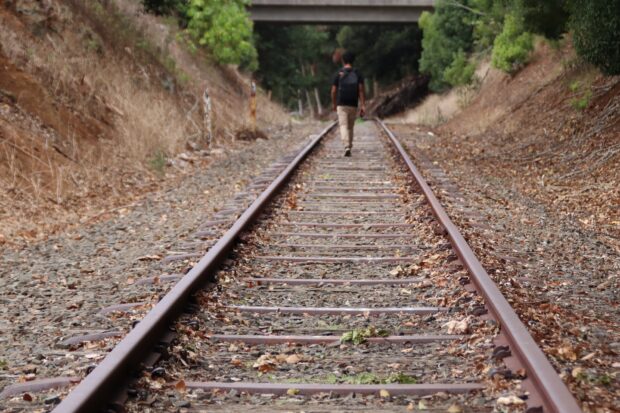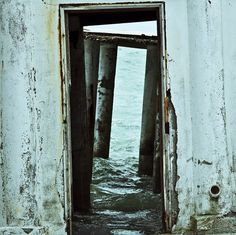You have no items in your cart. Want to get some nice things?
Go shopping
Just next to a football ground and the wide, cobbled yard where men would queue on Saturday for the turnstiles, there was a boundary fence to railway tracks five metres below. There was a hole in that fence, but on a Monday there was no security camera to monitor the crowd, and no fans to witness trespassers on the railway. If there had been a recording it could have been analysed and many lives would have taken a different course. It would have shown two boys slipping through the fence to take a short cut to school; one slightly taller, the other with darker skin. They both wear school uniforms but their trousers have different patches, there are scuffs on the taller boy’s shoes and his school bag is much smaller. As they pass the railway sidings they point to an old guard’s van – a brake van – parked up, probably beyond its useful life. The taller boy runs towards it and mounts the platform, the shorter boy gesticulating to go: they need to go to school. If there had been a camera, and it had zoomed in, it would have seen the boy on the guard’s van laughing as he turns the brake wheel, while the other boy walks away as encouragement to follow. But the taller is now making history, not just a story to brag about to his friends.
If there had been a camera it would have picked up that the guards van is now moving down the incline towards the main tracks. The shorter boy, agitated and confused in his movements, waves his arms at the other to get off the wagon. But it is too late. The event is under way. Still laughing, the boy jumps of the wagon and runs away. The shorter boy starts to walk towards the van, hesitates, then also runs away. The back of the brake van slowly disappears left out of the camera frame, just as a local train arrives from the right of the screen. As it too leaves the screen the camera shakes on its mountings and after a few seconds of fog the image disappears.
But there was no camera, no footage to be used at the accident enquiry, no witnesses to the event, just an engineer’s report that recorded that the brake van was old and should never have been stored in the disused cattle market sidings.
The football ground is now gone, replaced by a large supermarket and car park. Next to the entrance, just below a CCTV camera, there is a bronze plaque commemorating the train crash: the serious injury of 23 people and four deaths. One, Kevin Harvey, was 3 years old, his mother, Lorraine, only 22. Kevin’s twin, Mhairi, survived profoundly disabled. The driver, Jim Reid, lost both legs in the accident and took his own life a few months later. That was all twenty years ago.
Twenty years to the day, Platform 4, Queen Street Station, Greg steps off the train. It is just after rush hour and the station is collecting off-peak travellers heading out of Glasgow. There are CCTV cameras on the concourse and in Vincent Street where Greg walks towards a tall office building. He passes sandwich shops, cut price retailers, shoe shops, and homeless people wrapped in stained sleeping bags on cardboard mattresses. A gap in the street reveals a church in a sterile precinct occupied by drinkers sitting on steps and benches, some prostrate on the damp cobbles. Customers are having breakfast in a café opposite the church, drinking coffee, checking diaries, wondering how so many men have got themselves into such a state. Greg has often been seen talking to the drunks and giving them money. He has listened to their stories of mental breakdown, crime, alcohol and drugs.
Standing, facing the church, with his back to the café, is a man with all the attributes of homelessness: there are stains on his trousers, and his woollen hat is shredded like it is trying to escape. The staff in the café recognise his jacket, a distinctive orange blanket with a Native American motif on the back. Local police would recognise it too as he is known to them for several affrays. There are two takeaway coffee cups in his filthy hands. He offers one to Greg, who it seems he has been expecting. They walk out of view near recycling bins. They talk, some assume, and reappear guiltily a few minutes later, with bowed heads.
In the lift of his office building, Greg looks at his reflection in the mirror: his dark eyes have become darker, he has added a beard in recent months and his hair has grown untidily to his shoulders. It needs washing. He can see why his friends are concerned. They worry about his marriage, that his wife has moved to live with her mother, that he is not moving on with his life, that he lives in cheap rented accommodation and has forgotten how to iron his clothes. They considered him a snappy dresser ten years ago. He seemed alive then. Now he walks as though he is pulling a reluctant mule or being followed by one.
But what is worrying Greg is not reflected in the mirror or what others can see on the outside. Greg’s issues are like the writing in a stick of rock, tightly wrapped, hanging in a seaside shop window. After twenty years the label is faded and the cellophane is unravelling. He knows what the writing says, all the way through. He is coming to a place that he always feared he would, ever since the train crash, ever since he married.
Trains to the Scottish village of Plockton come from Inverness or Glasgow. Either way, it’s a long, slow and beautiful journey to the remote village of only a few hundred inhabitants overlooking Loch Carron and the sea beyond. Plockton Station is small, unmanned, and served by four trains a day. It sits isolated in soft hills greened by the rain and sea air from the Gulf Stream. Clouds frame every view, like a proscenium to a painted world where soft mists mute the colours and smudge the lines. But no one is painting today. If there were, they would see a man, freshly shaven with short hair, alight from a train with a single bag. The man closes the door and squints myopic eyes. No other passenger alights. There is a woman on the platform. She waves and smiles. He waves back. If the painter looks carefully, walking towards the woman in the wheelchair to find more detail, they would see several rings on her left hand, including a gold band and a bracelet with her name – Mhairi.
The man walks towards the woman, puts his bag down, kneels down and hugs her. His head is in her lap.
If there were a painting of the scene hung in a gallery, we would see that the man is Greg. But what would be concluded from his weight loss, his visual decline, and his demeanour? He looks like he has been carrying a great weight that cannot be offloaded. A weight that drove his school friend to drug abuse, depression and homelessness. Is Greg in the final stage of a lifetime of silence, lies and guilt for Mhairi’s life of disability and pain? Should the painter add ghost figures to the context, a train driver, say, or a woman holding a small child?
The painter’s brush darkens the northern sky in the middle of the composition above the man kneeling like a penitent seeking absolution. Greg’s cheek bones are highlighted but his eyes are blank, and Mhairi is still smiling, obviously not knowing what he is about to say.
The painting could record a scene that the camera didn’t twenty years ago. Greg is telling Mhairi about a short cut to school and which boy unleashed the brake and which boy ran away.
About CG Casci
CG Casci spent decades as a designer which involved travel, writing for professional press, brochures and websites, and being a contributor to design competition panels. His compulsion to recount stories as travel logs, sketchbooks and letters has more recently manifested as fiction. Between research for his book on the mechanics of the evolution of cities he is writing a fictionalised account of his grandfather’s ninety-nine year life. Recent short stories have been published by Mono, Litro, Fictionette, The Short Story Project and Christopher Fielden’s 2023 Anthology of humorous short stories.




